Domestic cats in the United States are facing an obesity crisis. About 60% are overweight or obese. Keeping Persian cats at the right weight is crucial. It helps with their health and life quality.
The right weight for a Persian cat does more than just look good. It’s key to them living a long, healthy life. Both their elegant size and beautiful fur depend on it.
Finding the ideal size for your Persian is crucial. Females usually weigh 5.3 to 8.4 lbs, and males 7.3 to 10.4 lbs. Staying within these limits helps avoid diabetes, joint pains, and heart issues. This means a happier, healthier pet.
Key Takeaways
- Understanding the ideal weight for Persian cats is crucial to their health and longevity
- Adult female Persian cats should weigh between 5.3 to 8.4 lbs
- Adult male Persian cats should weigh between 7.3 to 10.4 lbs
- Regular monitoring of your Persian cat’s weight helps in maintaining their overall well-being
- Adhering to Persian cat weight guidelines can prevent common health issues associated with obesity
Understanding Healthy Weight Ranges for Persian Cats

Keeping your Persian cat at a healthy weight is vital for its health and happiness. Males usually weigh between 4 to 6kg, and females between 3.2 to 4.5kg. It’s important to know these differences to care for your cat properly.
Using a Persian cat weight chart helps you keep track of your cat’s weight. These charts show the best weight for different ages. This makes it easy to notice if your cat is gaining or losing weight too quickly, which could mean a health problem.
| Gender | Weight Range |
|---|---|
| Male | 4 to 6kg |
| Female | 3.2 to 4.5kg |
Checking your cat’s weight often can stop big health issues like being too fat or too thin. Use weight charts and check your cat’s weight regularly. This helps keep your Persian cat at a good weight.
Knowing your cat’s average weight helps in many ways. It lets you provide the best care. And it helps you catch and fix weight problems early. This way, you can keep your Persian cat healthy and happy all its life.
Factors Affecting Persian Cat Weight
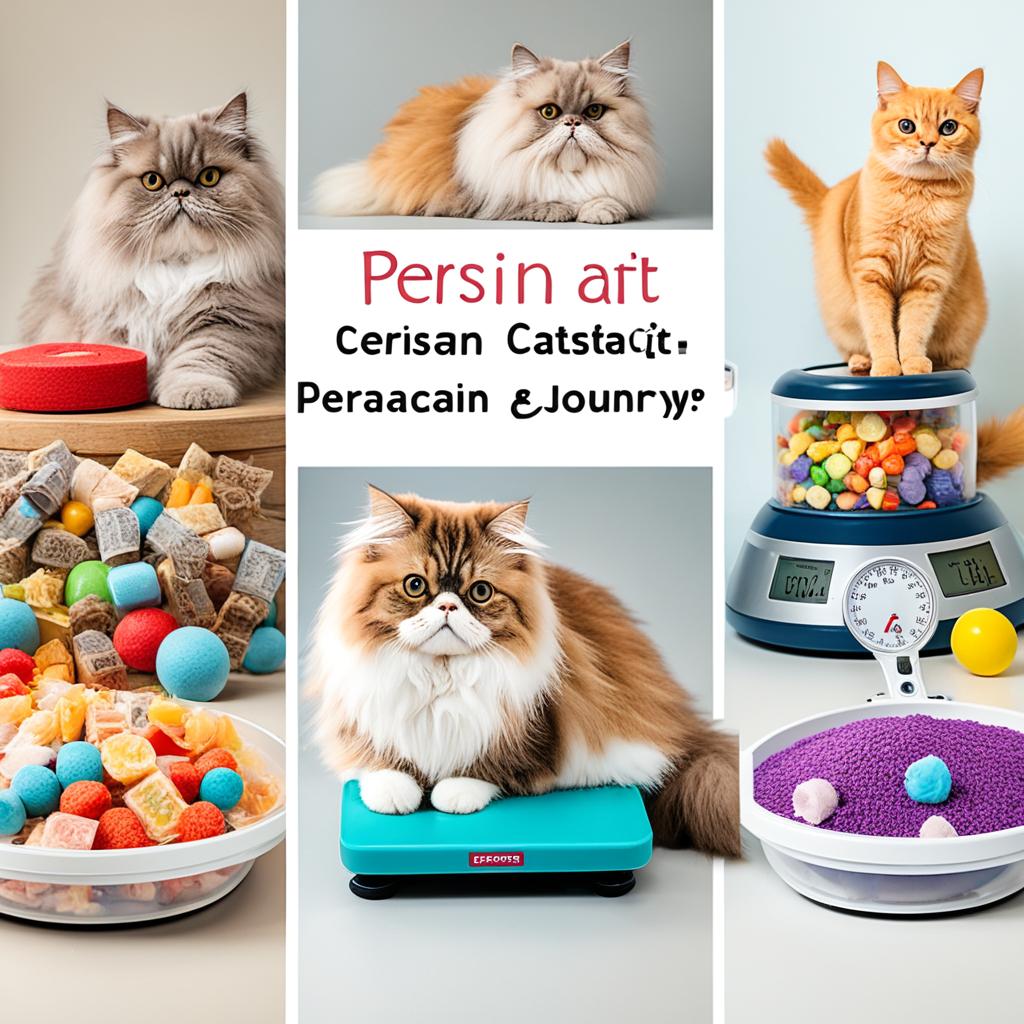
When you wonder What Is the Ideal Weight for a Persian Cat?, many things play a part. Persian cats have beautiful coats and are very calm. They need proper care to stay at a good weight. Key things affecting their weight include gender, age, genes, what they eat, and how much they exercise.
Gender
Gender is a top factor affecting Persian cat weight. Typically, males weigh more than females. You should keep an eye on this weight difference. This helps know how much should a Persian cat weigh during different life stages.
Age
Age plays a big role in Persian cats’ weight, too. Kittens gain weight as they develop, needing more food. Older cats also have changing needs. Monitoring weight by age is key to knowing what is the ideal weight for a Persian cat at each life stage.
Genetics
Don’t forget about genetics when thinking about how much should a Persian cat weigh. Some cat breeds and their family traits affect their weight and health. Knowing your cat’s family history can help set the right weight range for them.
Nutrition
Getting the right food is essential for Persian cat weight control. The kind of food, the amount, and how often they eat are important. A balanced diet keeps their weight in check.
Exercise and Activity Level
Activity is crucial for a Persian cat’s weight. Play and fun with them keep their weight healthy. This way, they won’t become lazy or too heavy.
Knowing about these factors affecting Persian cat weight helps you care for your cat. This knowledge means you can keep them at a great weight as they grow.
What Is the Ideal Weight for a Persian Cat?
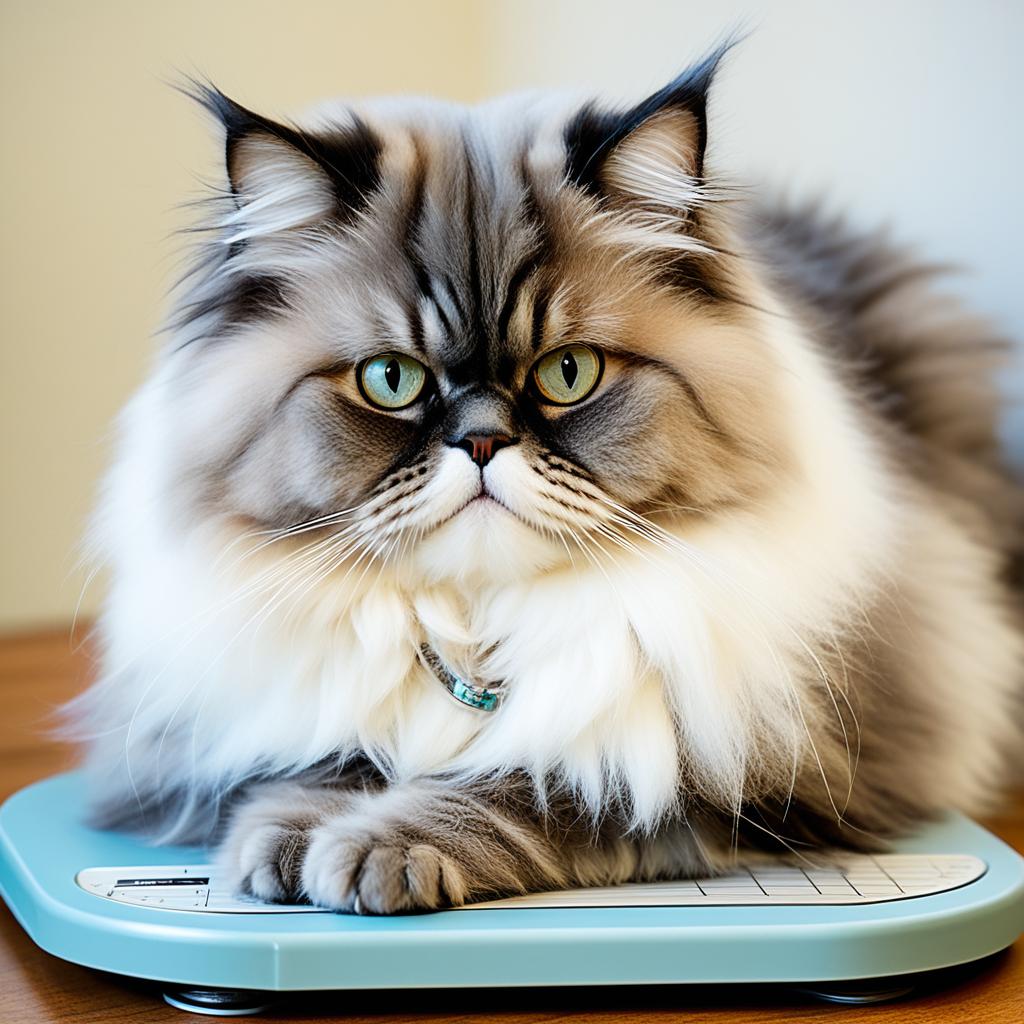
Keeping your Persian cat at a good weight is key for its health. It’s important to know what weight is right for male and female Persian cats. This helps you take better care of them.
Typical Weight Ranges for Males and Females
For male Persian cats, the right weight is usually between 7.3 to 10.4 lbs. Female Persians should be between 5.3 to 8.4 lbs. Staying within these weight ranges is vital for their health.
Persian Cat Weight Chart
A weight chart can show you how your cat’s weight is doing. Here’s a chart that shows weights for male and female Persian cats by age:
| Age (Months) | Male Weight (lbs) | Female Weight (lbs) |
|---|---|---|
| 3 | 1.9 – 2.6 | 1.5 – 2.4 |
| 6 | 3.8 – 5.5 | 3.0 – 4.3 |
| 12 | 6.6 – 9.2 | 4.8 – 7.5 |
| 24 | 7.3 – 10.4 | 5.3 – 8.4 |
Using this chart, you can keep a close eye on your Persian cat’s weight. This helps keep them healthy.
Monitoring Your Persian Cat’s Weight

Keeping an eye on your Persian cat’s weight is key. It ensures they are in line with Persian cat weight rules. Regular checks quickly reveal any size changes.
Using the right tools is crucial. A reliable scale and measuring tapes are a must for accurate checks. It’s also vital to weigh your cat at the same time weekly. This makes the readings more precise. Comparing your cat’s weight against growth charts for Persians helps too.
So, following these weight guidelines for Persian cats is smart. It lets you spot any differences and act early. Knowing the typical size for male and female Persians is also critical. This careful monitoring keeps your cat healthy and happy.
How to Identify if Your Persian Cat is Overweight or Underweight
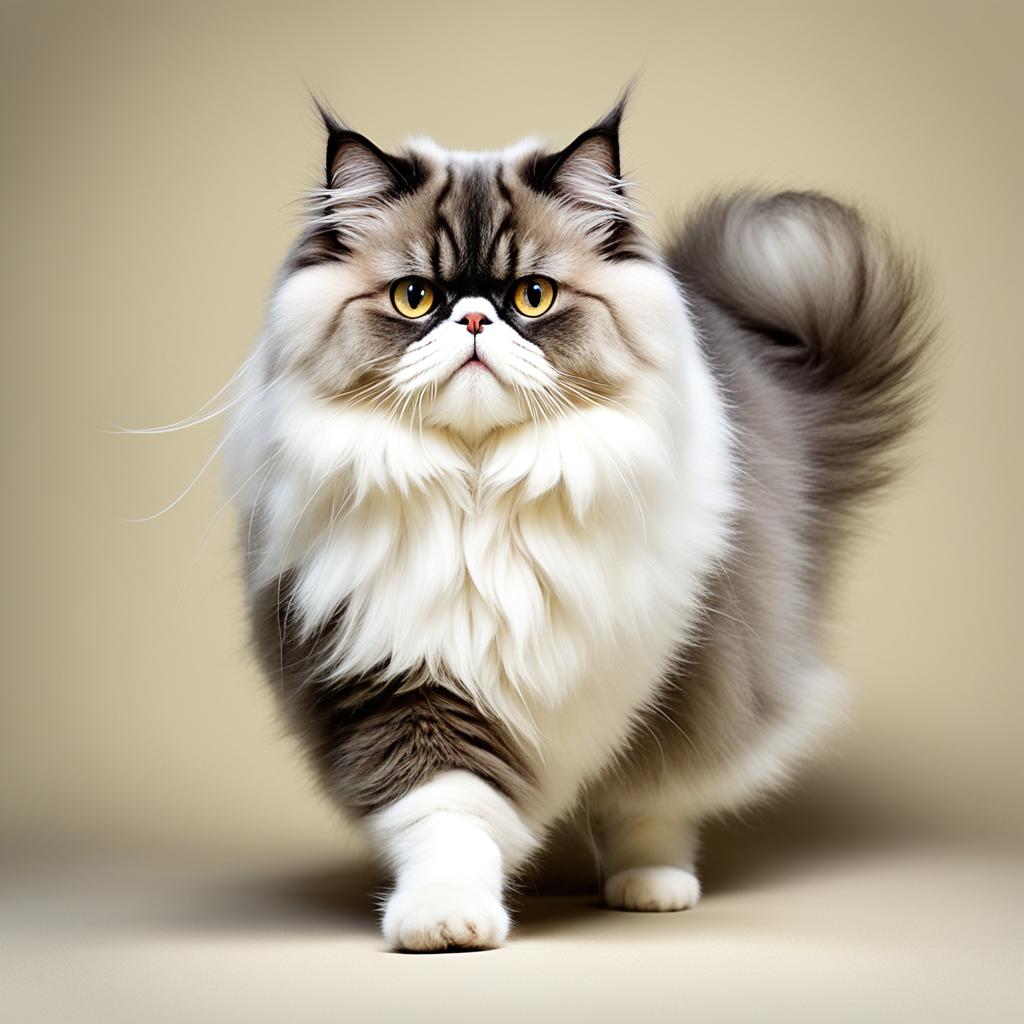
Keeping an eye on your Persian cat’s weight is important for their health. Knowing the signs of overweight or underweight can alert you early.
Signs of an Overweight Persian Cat
An overweight Persian cat shows clear signs. You might not feel their ribs due to the extra fat. They might not have a visible waistline and their stomach could be big. Knowing these signs can help avoid health problems.
Signs of an Underweight Persian Cat
A *Persian cat underweight* will have bones showing, like ribs and spine. They could have a very thin stomach and a visible waist. Recognizing these signs early can guide you to help your cat gain weight.
Body Condition Score (BSC)
The *Body Condition Score for cats* is a good way to check your Persian cat’s weight. This method looks at the balance of muscle and fat. Scoring between 4 and 5 is good, but below or above means your cat might be under or overweight.
Diet Tips for Maintaining a Healthy Weight
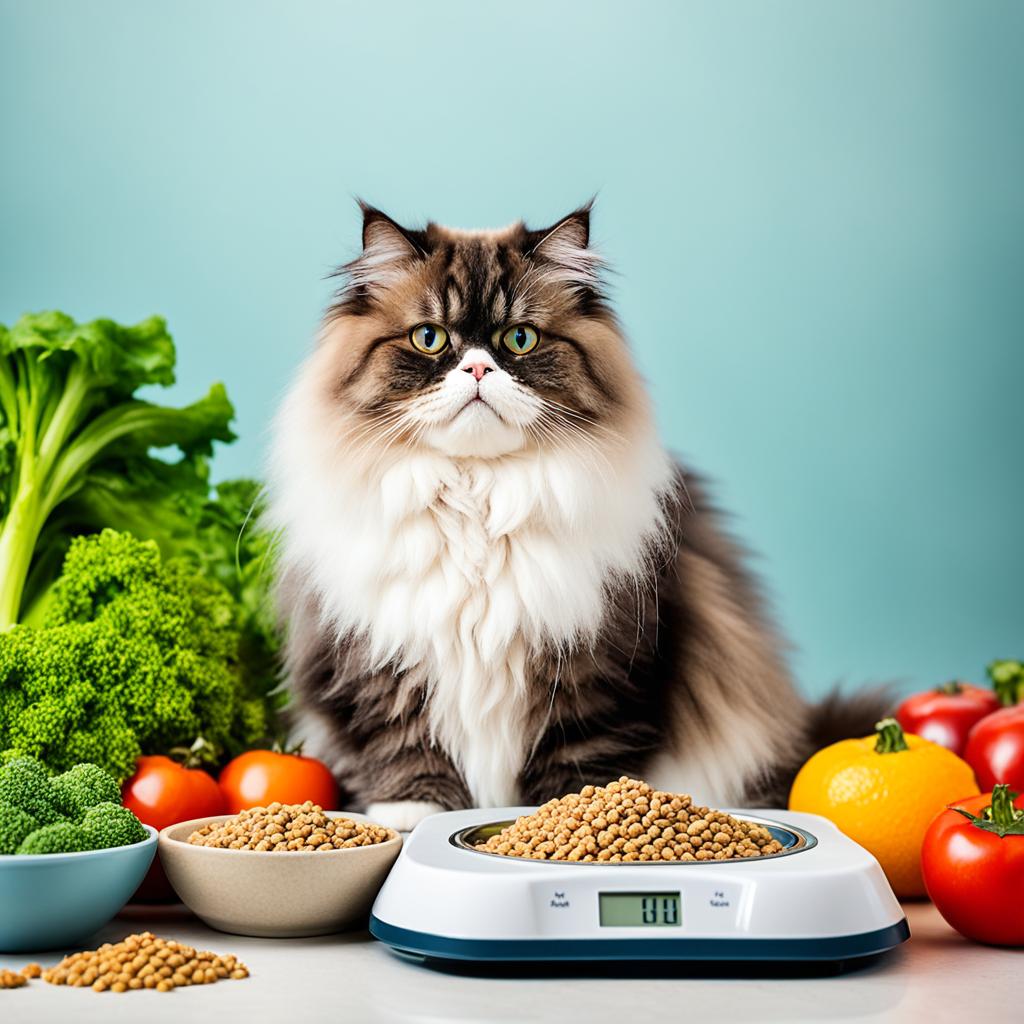
Your Persian cat’s healthy weight is vital for its well-being. A good diet, controlling portions, and choosing the right food are key. Let’s look at tips to keep your Persian cat healthy.
Nutritional Needs of Persian Cats
Persian cats need a special diet to stay happy and healthy. They should eat foods high in animal proteins but not too high in fats. These foods should also be rich in taurine, omega fatty acids, and vitamins. Carbs can be in their diet a bit to give them energy.
Portion Control and Feeding Frequency
It’s important to control how much your cat eats to avoid overfeeding them. Persian cats can gain weight easily. It’s best to give them their food in measured portions at set times. This keeps them from eating too much. Try to feed them a certain amount based on their weight, up to three times a day. Here’s a guideline:
| Weight of Cat (lbs) | Daily Food Portion (grams) | Feeding Frequency |
|---|---|---|
| 5 – 7 | 50 – 60 | 2-3 times a day |
| 7 – 10 | 60 – 75 | 2-3 times a day |
| 10 – 12 | 75 – 90 | 3 times a day |
Choosing the Right Cat Food
Picking the best cat food is crucial for your cat’s weight. Bran-free foods with real meat as the top ingredient are great. Brands like Royal Canin, Blue Buffalo, and Hill’s Science Diet make food just for this. These foods give your cat all they need, without too many calories.
Following these diet tips is the key to a healthy, happy Persian cat. Focus on their nutrition, portion control, and choose the best food. This will make a big difference in their life.
Exercise and Activities to Keep Your Persian Cat Fit
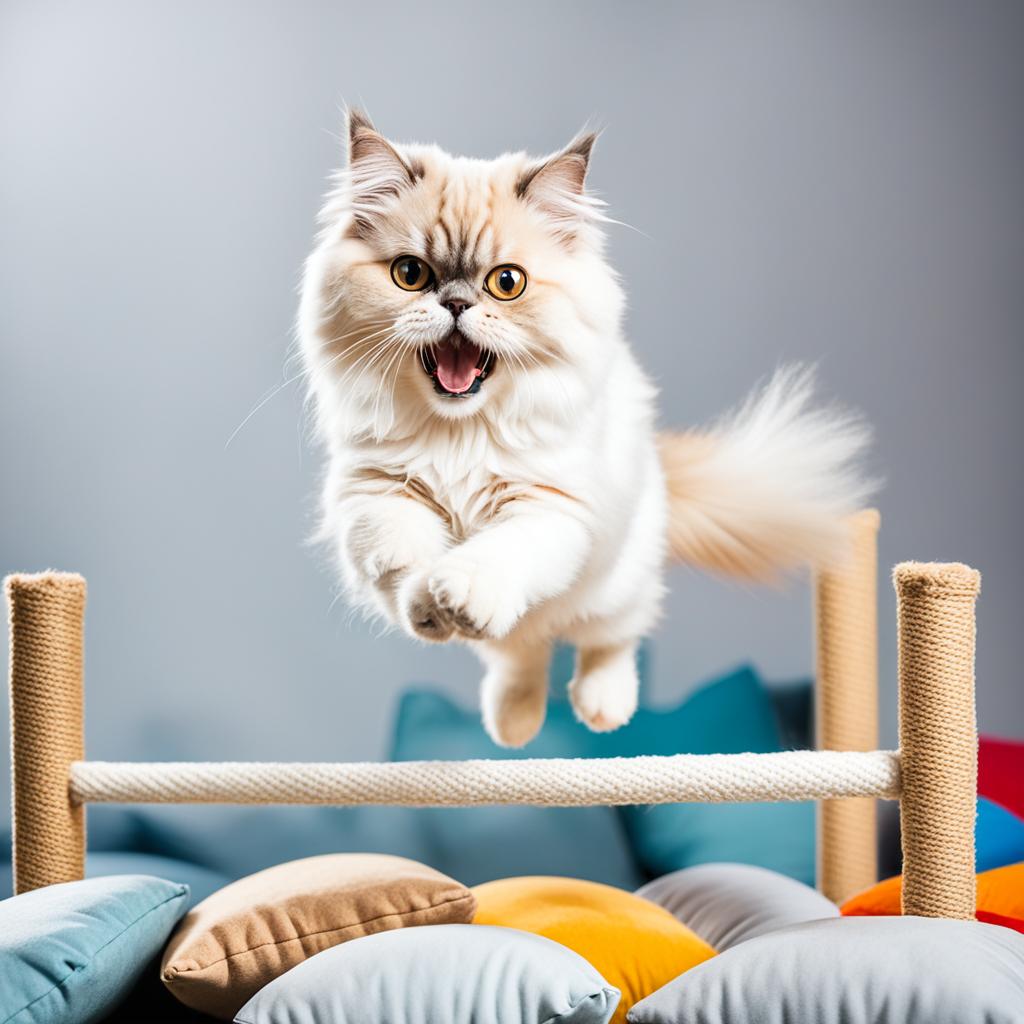
Keeping your Persian cat active is vital for their health. They are known for their beautiful coats and calm nature. Yet, they still need playtime and toys to stay healthy.
Encouraging Playtime
Playtime is key for Persian cats. It helps them burn energy and stay at a healthy weight. Make sure to play with them every day. This can be anything from chasing a string to batting a feather toy.
Interactive Toys and Games
Interactive toys are great for physical and mental activity. Laser pointers, moving mice, and food puzzles are perfect. They keep your cat busy and prevent boredom.
Setting Up an Exercise Routine
A good routine is essential for your cat’s fitness. This can include chasing games, hide-and-seek, and even some agility training. Mixing up the activities works different muscles, giving them a full workout.
- Start with short, frequent play sessions to build endurance.
- Incorporate interactive cat toys to diversify activities.
- Create an obstacle course using household items to enhance agility.
- Gradually increase the intensity and duration of the exercises.
Adding these steps to your daily plan will keep your Persian cat happy and healthy. Daily play, the right toys, and structured workouts will keep them in top shape. Your cat will look and feel great.
When to Consult a Veterinarian About Your Persian Cat’s Weight
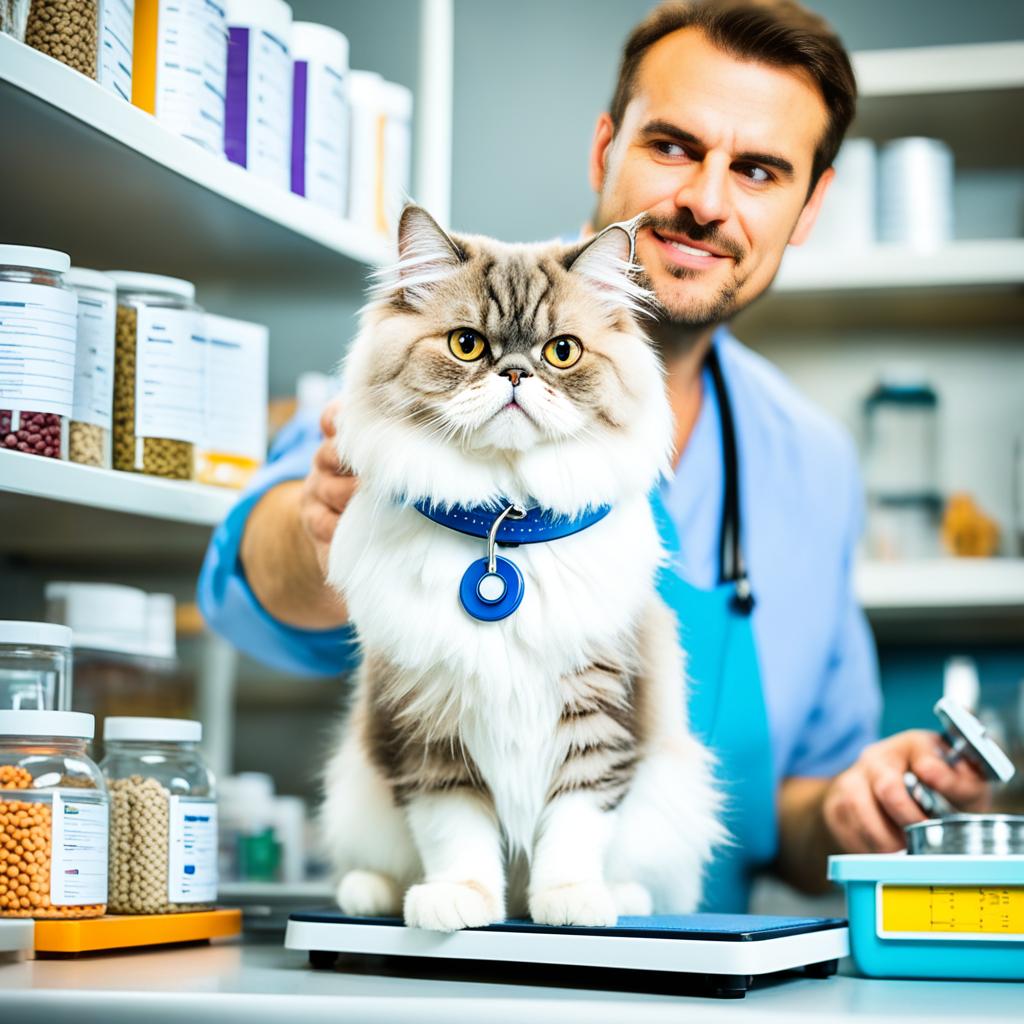
Taking care of a Persian cat’s weight is vital for their health. If you see big changes in weight suddenly, it’s time to talk to a vet. These changes can be signs of health problems, like obesity, or something else.
Strange weight changes might point to hidden issues that need professional eyes on them. Your cat’s metabolism, any illnesses, or stomach problems could be causing this. Getting a vet’s advice can help find the root of the issue.
If your Persian cat doesn’t match the usual weight norms, it might be too heavy or too thin. Act fast by getting a vet to check your cat. This could fix their weight and keep them healthy.
When you talk to a vet about your cat’s weight, your cat gets a full health check and the right advice. The vet can make a plan that’s just for your cat. This can help avoid problems like diabetes or heart disease in overweight cats.
Getting your cat checked by a vet regularly is good for keeping their weight in check. Vets can also catch and treat any issues early. This helps your cat live a long, happy life.
Conclusion
Keeping your Persian cat at the right weight is key for their health and happiness. Make sure they eat well, exercise regularly, and check their weight often. This helps avoid health problems, keeping your cat around for a long time.
Check your cat’s weight often and feed them a diet perfect for Persians. This diet should be full of animal protein. Make sure they stay active. Quality cat food and watching their portions are essential for their weight.
Also, visit the vet regularly for their health checks. These visits can catch any health issues early. This ensures your cat stays at a healthy weight. Being diligent about these steps will help your Persian cat live a long and happy life.
Understanding these points will help you keep your Persian cat healthy. A healthy weight means they can be happy all their life. So, follow these tips for many fun and healthy years with your cat.




